Mintages
Rarest A-Z 10p coins revealed! 2019 Mintage Figures Update
Exciting news! The Royal Mint have revealed the latest mintage figures for 2019 coins!
Three 50p coins entered circulation in 2019 and collectors across the nation have been debating how rare each one might be.
What’s more, we were all eagerly awaiting the reveal of the mintage figures for the 2019 A-Z 10p coins.
But now the official figures have been revealed and it looks like there are some particularly rare ones we should be looking out for…
The Rarest A-Z 10p Coins!

Whilst each of the 2018 dated A-Z 10p coins had the same mintage of 220,000, this year the mintages are varied among the designs!
Collectors who have managed to find the 2019 dated Q, W, Y, Z, and R 10p coins will be delighted to see that these have a lower mintage than the other 21 designs from that year.

The 2019 World Wide Web, Yeoman Warders and Zebra Crossing 10p coins all have a mintage of JUST 63,000! When you compare that to the rarest 50p in circulation, the Kew Gardens 50p, which has a circulating mintage of 210,000, it puts into perspective just how rare these 10p coins are.
When you combine the 2018 and 2019 mintages for these coins, it confirms that a total of 283,000 of each design has entered circulation.
The other 10p coins to look out for are the Robin and Queuing 10p, with a 2019 mintage of 64,000 and 83,000 respectively.
Are you lucky enough to have these coins in your change? Let us know in the comments below!
50p Mintage Update

Sherlock and Paddington Join the Chart!
The Paddington Bear coins are some of the most popular 50ps in recent years and collectors have been waiting to find out just how rare they are.
It’s now been confirmed that 9,001,000 of each 2019 design (Paddington at the Tower and Paddington at St. Paul’s Cathedral) were issued into circulation.
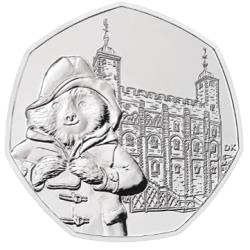

Whilst these coins aren’t exactly rare, they are certainly a collector favourite, with children, parents, and 50p collectors alike all wanting to find all four coins from the series in their change. Have you got these coins in your collection? Let us know in the comments below!
The mintage figure for the 2019 Sherlock Holmes 50p has also been confirmed. 8,602,000 of these 50p coins, celebrating the 160th anniversary of the birth of author Sir Arthur Conan Doyle, were struck for circulation.
What about the Olympic 50ps?
In 2012, the release of the Olympic 50p series kick started a collecting frenzy across the nation.
It’s estimated that around 75% of these coins have been removed from circulation by collectors which means they are incredibly sought-after, especially considering these 50ps have some of the lowest mintage figures in circulation…
Many of the Olympic 50ps have a mintage less than 2,000,000 with the rarest (the Olympic Football 50p) having a mintage of just 1,125,500.

Taking these rare 50ps into consideration, the 2018 Peter Rabbit and Flopsy Bunny coins would sit in joint sixth position, below the Kew Gardens, Football, Wrestling, Judo and Triathlon 50ps.
£2 Coin Update
As well as updating the 50p mintage figures, The Royal Mint also revealed that no £2 coins were issued into circulation in 2019.
There have been no new £2 coins issued into circulation since 2016, which may in part be due to the introduction of the new 12-sided £1 coin in 2017.

It was recently confirmed that The Royal Mint has no plans to strike any £2 coins for circulation for the next 10 years, so unfortunately, there may not be any mintage updates for this denomination for a while.
No 1p or 2p coins entered circulation in 2018 either, perhaps suggesting it’s time we question what the future has in store for our beloved coppers.
Have you been lucky enough to find any of these coins in your change? It’s always exciting when new mintage figures are revealed and your realise just how rare the change in your pocket really is!
We’ll be updating the Change Checker Scarcity Index this month and it will be exciting to see how these new figures impact the index.
If you’re interested in coin collecting, our Change Checker web app is completely free to use and allows users to:
– Find and identify the coins in their pocket
– Collect and track the coins they have
– Swap their spare coins with other Change Checkers

Sign up today at: www.changechecker.org/app
Your guide to the Pre-1997 £2 Coins
In 1986, a brand new UK denomination was introduced in the form of a £2 coin.
These original £2 coins were never commonly found in circulation, as they were mainly struck for collectors. This made them much rarer than their successor, the bi-metallic £2 coin, as their mintage figures were much lower.
The pre-1997 £2 coins are still legal tender but they’re not used in circulation and banks/shops can refuse to accept them. Despite this, they still remain incredibly popular amongst collectors!
So, in this blog, we’ve put together a guide to the pre-1997 £2 coins, including everything you need to know about these collectable commemoratives.
What are old specification £2 coins?
The £2 coin has changed in its appearance since it’s first introduction in 1986…
The familiar, fully circulating bi-metallic £2 coin, was only introduced in 1998 and we’ve seen already seen over 50 different designs in total!
But prior to this, single-coloured, nickel-brass £2 coins were issued, purely to mark special occasions.
Between 1986 and 1996, there were seven different designs of the single-coloured £2 coins.

Spot the difference…
| Pre-1997 (old specification) | 1997 onwards (new specification) | |
| Weight | 15.976g | 12g |
| Diameter | 28.4mm | 28.4mm |
| Metal | Nickel-brass | Outer Nickel-Brass Inner Cupro-Nickel |
| Obverse Effigy | 1969-1985 – 2nd Portrait, Arnold Machin 1985-1997 – 3rd Portrait, Raphael Maklouf | 1997-2015 – 4th Portrait, Ian Rank-Broadley 2015-onwards – 5th Portrait, Jody Clark |
As you can see, although the diameter of the £2 coin stayed the same, the weight was significantly heavier in the pre-1997 £2 coins!
The metal composition also changed so that the new bi-metallic coin could be distinguishable from the other coins in circulation.
So, how many of these coins were issued? Let’s take a look at our Pre-1997 £2 Mintage Chart and see..

You might have spotted the top coin in our chart has a mintage of JUST 381,400! Let’s take a look at each of these coins in closer detail to get the full story…
1986 Commonwealth Games
Fact file:
- Year of issue: 1986
- Obverse designer: Arnold Machin
- Reverse designer: Norman Sillman
- Mintage: 8,212,184

The 1986 Commonwealth Games £2 coin changed the face of UK commemorative coins, being the first of its denomination to be struck and the first British coin being issued to commemorate a sporting event.
The thirteenth Commonwealth Games were held in Edinburgh in 1986, and are well remembered for being boycotted by 32 of the 59 eligible countries who did not agree with Britain’s sporting connections to South Africa during the Apartheid era.
The reverse design features a thistle encircled by a laurel wreath over the cross of St Andrew.
1996 Football
Fact file:
- Year of issue: 1996
- Obverse designer: Raphael Maklouf
- Reverse designer: John Mills
- Mintage: 5,141,350

In 1996, England hosted the 10th European football championship and a commemorative £2 coin was struck in celebration of football.
The reverse design resembles a football, and is accentuated by the unusual concave surface of the coin. The year of 1996 is prominent on the design and the sixteen small rings represent the sixteen teams competing in the tournament.
The eventual winners of the competition were Germany who knocked out hosts England in the semi-finals.
1995 Peace
Fact file:
- Year of issue: 1995
- Obverse designer: Raphael Maklouf
- Reverse designer: John Mills
- Mintage: 4,394,566

This commemorative £2 was issued in 1995 to mark 50 years since the end of World War II.
Victory in Europe Day, or VE Day, is the 8th May 1945 when armed forces formally accepted the surrender of Nazi Germany. Upon the news, jubilant crowds sang and danced in the streets of London, New York, Paris and Moscow.
The reverse design by John Mills features a dove as “a symbol of aspiring peace; a calm, bountiful and optimistic image”.
1989 Bill of Right
Fact file:
- Year of issue: 1989
- Obverse designer: Raphael Maklouf
- Reverse designer: John Lobban
- Mintage: 4,392,825

In 1689, Prince William and Mary accepted the Declaration of Rights prior to being offered the throne. This effectively shifted the balance of power from the Crown to Parliament and changed the course of British political history.
This £2 coin was issued in 1989 to commemorate the 300th anniversary of this landmark Act. There were 2 versions of the coin issued – English and Scottish.
This coin is the English reverse design , which features the Crown of St. Edward and the inscription ‘Tercentenary of the Bill of Rights’
1995 United Nations
Fact file:
- Year of issue: 1995
- Obverse designer: Raphael Maklouf
- Reverse designer: Michael Rizzello
- Mintage: 1,668,575

The United Nations was established in the aftermath of World War II with the aim of maintaining world peace and to work for social progress.
Since its creation in 1945, the UN has sought to resolve potential conflicts peacefully and fight against poverty, hunger and disease across the world.
This commemorative £2 coin issued in 1995 marks 50 years since the inception of the UN, and features flags of nations accompanying the 50th anniversary symbol.
1994 Bank of England
Fact file:
- Year of issue: 1994
- Obverse designer: Raphael Maklouf
- Reverse designer: Leslie Durbin
- Mintage: 1,668,575

When William and Mary came to the throne, public finances were weak and the system of money and credit were in disarray.
The Bank of England was founded in 1694 to act as the Government’s banker and debt manager, and its position as the centre of the UK’s financial system is maintained to this day.
This commemorative £2 was issued in 1994 to mark its 300th anniversary. The reverse design features the original Corporate Seal of the Bank of England and distinctive Cypher of William and Mary.
1989 Claim of Right
Fact file:
- Year of issue: 1989
- Obverse designer: Raphael Maklouf
- Reverse designer: John Lobban
- Mintage: 381,400

This is the second coin to be issued in 1989 to commemorate the 300th anniversary of Prince William and Mary accepting the Declaration of Rights.
This Scottish reverse design features the Crown of Scotland and the inscription ‘Tercentenary of the Claim of Right’.
The mintage for this £2 however, is much lower. With just 381,400 issued, this technically makes it the rarest £2 coin ever! In comparison, the UK’s current rarest circulating £2 coin, the 2002 Commonwealth Games – Ireland, has a mintage of 485,500!
So hopefully our guide to the Pre-1997 £2 coins will help you along the way to expanding your collection!
What’s most exciting about all seven of these coins is that despite still being legal tender, they’re not used in circulation anymore and banks/shops can refuse to accept them. This makes these coins particularly sought-after by collectors!
Do you have any of these coins in your collection already? Let us know in the comments below!
Own the UK’s FIRST-EVER Commemorative £2 Coin!
Your guide to the Pre-1997 50p Coins
In recent years, the 50 pence piece has become the most collected coin in the world.
But here at Change Checker, we get asked a lot about the older specification 50p coins… “How many old 50ps are there to collect? How rare are my old 50ps? Can I still find these coins in circulation?” are just a few of the questions frequently asked.
So, we’ve put together a guide answering your questions and giving you the key facts we think you need to know about these out-of-circulation coins!
What are old specification 50ps?
The 50p emerged in 1969 as the first coin in the new decimal series.
It was also the world’s first seven-sided coin and has since become the most collected coin in the country!
In 1997, the specification for the 50p changed to the size and feel we’re familiar with today.
But, between 1969-1997, there were five 50p coins issued in these older specifications. But what was different about these coins?
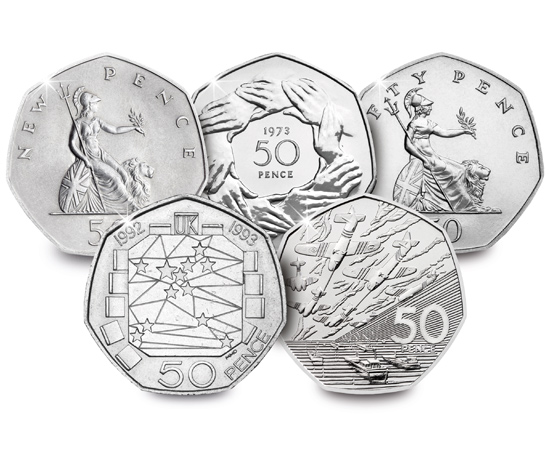
Left to Right: Britannia New Pence, Entry to the EEC, Britannia Fifty Pence, EC Presidency, D-Day
Spot the difference
| Pre-1997 (old specification) | 1998 onwards (new specification) | |
| Weight | 13.05g | 8.00g |
| Diameter | 30mm | 27.30mm |
| Metal | Cupro-Nickel | Cupro-Nickel |
| Obverse Effigy | 1969-1985 – 2nd Portrait, Arnold Machin 1985-1997 – 3rd Portrait, Raphael Maklouf | 1998-2015 – 4th Portrait, Ian Rank-Broadley 2015-onwards – 5th Portrait, Jody Clark |
As you can see, despite the 50p retaining the same metal composition, the older specification was much bigger and heavier than the coin we’re used to today – imagine carrying around a bundle of those in your pockets!
These coins were removed from circulation when the new specifications were introduced, so you won’t come across these in your change.
What’s more, shop keepers and banks won’t accept these as legal tender, so we imagine a lot of these will have been kept by collectors for their private collections!
So, how many of these coins were issued? Let’s take a look at our Pre-1997 50p Mintage Chart and see..
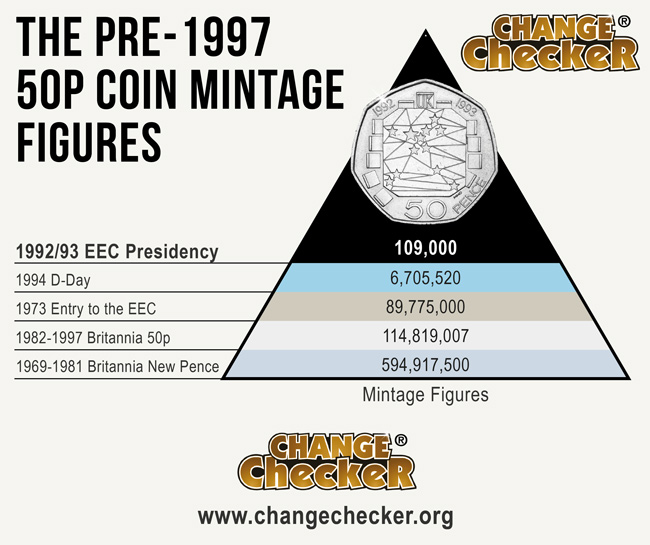
You might have spotted the top coin in our chart has a mintage of JUST 109,000! Let’s take a look at each of these coins in closer detail to get the full story..
1969 Britannia New Pence
Fact File:
- Year of Issue: 1969-1981
- Obverse Designer: Arnold Machin
- Reverse Designer: Christopher Ironside
- Mintage: 594,917,500

The New Pence 50p was the first 50p coin ever issued and it featured Christopher Ironside’s iconic Britannia design.
Britannia first appeared on UK coinage in 1672 and since then has always been present on at least one denomination.
With a mintage of 594,917,500 is the most common of the pre-1997 50p designs, which is hardly surprising as it was the definitive 50p design between 1969-1981.
Despite it’s considerably high circulating mintage, this coin is still considered collectible as it’s no longer in circulation.
1973 Entry to the EEC 50p
Fact File:
- Year of Issue: 1973
- Obverse Designer: Arnold Machin
- Reverse Designer: David Wynne
- Mintage: 89,775,000
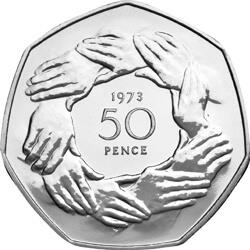
This coin was issued to celebrate the UK’s entry to the EU (then called the European Economic Council or the EEC).
With a mintage of 89,775,000 it is less common that the definitive design but not the rarest out there!
It is still incredibly sought-after by collectors though as this was the FIRST-EVER commemorative 50p!
1982 Britannia Fifty Pence
Fact File:
- Year of Issue: 1982/83/85
- Obverse Designer: Arnold Machin (1982/82) Raphael Maklouf (1985)
- Reverse Designer: Christopher Ironside
- Mintage: 114,819,007

In 1982 the ‘New Pence’ in the design was replaced with ‘Fifty Pence’ as the design was no longer considered new.
Although still the definitive design, this coin was only issued in 1982, 1983 and 1985 and featured two different portraits of Her Majesty on the obverse! Machin in ’82 and ’83 and the new Maklouf portrait in ’85.
With a mintage of 114,819,007, it’s the second most-common of the Pre-1997 50ps.
1992/93 EC Presidency 50p
Fact File:
- Year of Issue: 1992/93
- Obverse Designer: Raphael Maklouf
- Reverse Designer: Mary Milner
- Mintage: 109,000
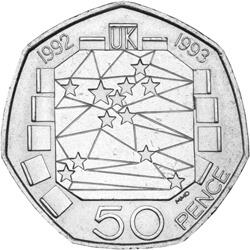
Designed by Mary Milner, this 50p celebrates the UK’s presidency of the European Council of Ministers.
Excitingly, this 50p is the RAREST ever UK 50p to enter circulation. With a mintage of just 109,000 it’s even rarer than the sought-after Kew Gardens 50p which has a mintage of 210,000.
As this coin is no longer in circulation AND has the lowest ever UK 50p circulating mintage, it’s incredibly sought-after by collectors and if you’re lucky enough to have one in your collection, you should be extremely pleased!
1994 D-Day Landings 50p
Fact File:
- Year of Issue: 1994
- Obverse Designer: Raphael Maklouf
- Reverse Designer: John Mills
- Mintage: 6,705,520
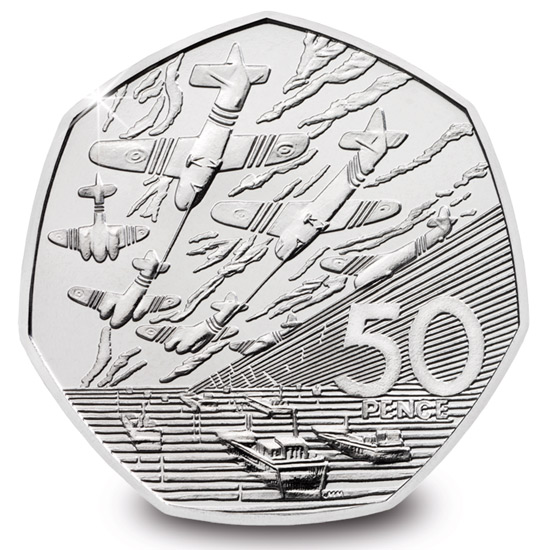
Issued to commemorate the 50th anniversary of the D-Day Landings, this was the final 50p issued in the older specifications.
Interestingly, this has been voted Change Checkers ‘Favourite Ever’ 50p!
With a mintage of 6,705,520 it is the second rarest of the pre-1997 50p coins.
So hopefully our guide to the Pre-1997 50p coins will help you along the way to expanding your collection!
What’s most exciting about all five of these coins is that now they’re out of circulation, they are all considered particularly sought-after by collectors!
Do you have any of these coins in your collection already? Let us know in the comments below!
Own the UK’s FIRST-EVER Commemorative 50p


